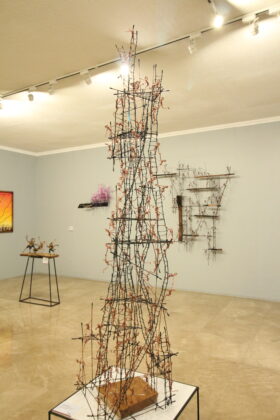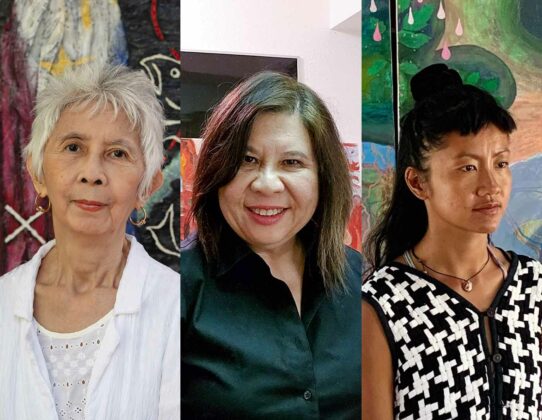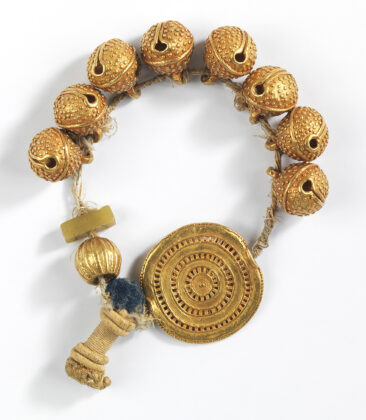Arts & Culture (02/14/24)
Araneta City holds Arts Month festival
ARANETA CITY is celebrating National Arts Month with “Love of Art,” a gathering of local artists and creatives presenting workshops. On Feb. 14, Khrisna Nanola-Marcos will lead a tote bag painting workshop. Meanwhile, rising Filipina saxophonist Cyndi Datu will serenade mallgoers at the Gateway Mall 1 activity area on Feb. 14 and at the Oasis Garden of Gateway on the evenings from Feb. 14 to 16.
Artists from Batangas combine music and visual art
THE “PLAYLIST 3: Symphony of Sight and Sound” exhibit at ARTablado in Robinsons Galleria will feature two artist groups from Batangas and their works inspired by movie soundtracks. From Arte Bauan are Yelcast, Ada Panopio, Windsor Magnaye, Jerwind Magnaye, Cheyzer Manalo, Ruby Bagsit, Sarah Jane Tumambing, Bill Perez, Batilyo, and Doy Kastilyo. From Arte Likha are Temyong, John Kier Contacte, Justin Magbojos, Joy Bagay, Sleygh, and Ria Manalo. There will be codes next to each piece that viewers can scan to hear the soundtrack that served as their inspiration. The exhibit is on view at ARTablado in Robinsons Galleria until Feb. 15.
Filipino dancer-filmmaker lectures on colonialism
AWARD-WINNING documentary filmmaker and ethnographer Patrick Alcedo will share his insights on the Philippine dance diaspora and its effect on the identity of Filipinos in a free online lecture on Feb. 16, 1 p.m. The industry practitioner will impart his expertise on the histories of colonialism and imperialism in the islands. He will likewise discuss the traditions and stories encapsulated in the Philippine folk and contemporary forms. The public discussion will be hosted by the Dance Program students of the De La Salle-College of Saint Benilde (DLS-CSB) School of Arts, Culture, and Performance in a webinar interview HISTOPHTV. It is an online platform that features prominent personalities and figures in the dance industry. Mr. Alcedo is the Dance Department chairperson of York University in Toronto, Canada. Interested participants may register at https://forms.gle/1A7duJxo5urcDcCB6.
Literary translations talk at Instituto Cervantes
SPANISH cultural center Instituto Cervantes will present a roundtable discussion titled “The Challenges of Literary Translations,” with literary translators Luis Castellví, Marlon James Sales, Alice Sun-Cua, and publisher Andrea Pasion-Flores. Following the recent publication of Nick Joaquin’s literary work in Spain, La mujer con dos ombligos: Cuentos y leyendas de Filipinas, they will hold an in-depth discussion centering on the challenges translators face on their tasks of translating literature. The event is in collaboration with the Embassy of Spain in the Philippines and the University of the Philippines’ Department of European Languages. It will be held at Instituto Cervantes’ branch in Intramuros on Feb. 19 at 2 p.m. Admission is free, and seating is on a first come, first served basis.
NCCA Gallery opens ‘KableArt’ and ‘DUGÓNGGINTÔ’
TWO solo exhibitions are on view at the National Commission for Culture and the Arts (NCCA) Gallery this Arts Month. “Coaxing Gestures, Transverse Visuals: The KableArt of Ruben Jasareno” showcases Mr. Jasareno’s creative approach to upcycled coaxial cables and wires that are mounted to evoke narratives of Philippine landscapes. Meanwhile, “DUGÓNGGINTÔ” highlights the craftsmanship of goldsmith Ely “Oslog” Arcilla, Jr. in collaboration with jewelry designer Adam Pereyra, as curated by Marian Pastor Roces. Both exhibitions run until Feb. 29 at the NCCA Gallery, located on the Ground Floor of the NCCA Bldg., General Luna St., Intramuros, Manila.
Rama, Hari returns for ARDP’s 2024 dance season
AFTER a highly acclaimed 2023 run, the concert-ballet Rama, Hari returns onstage by popular demand, opening the 2024 season of Alice Reyes Dance Philippines (ARDP). The production is the only collaboration that features the work of five National Artists: Alice Reyes for the direction and choreography, Ryan Cayabyab for the music, Bienvenido Lumbera for the libretto, Salvador Bernal for the production design, and Rolando Tinio for the English lyric translations. The production, which has both singers and dancers portraying each role, features singers Arman Ferrer and Vien King and dancers Richardson Yaado and Ejay Arisola as Rama; and singers Karylle Tatlonghari, Shiela Valderrama-Martinez, and Nica Tupas and dancers Monica Gana and Katrene San Miguel as Sita. There will be 2 p.m. and 7:30 p.m. shows from Feb. 16 to 18 and Feb. 23 to 25 at the Samsung Performing Arts Theater in Circuit, Makati. Reserve tickets via TicketWorld or ardancephilippinesinc@gmail.com.
Silverlens to represent three distinguished artists
SILVERLENS recently announced that it is representing artists Imelda Cajipe Endaya, Keka Enriquez, and Catalina Africa. This year, Ms. Endaya will unveil a solo exhibition at Silverlens Manila and debut at Art Basel Hong Kong, while Ms. Africa and Ms. Enriquez will participate in Silverlens’ Art Fair Philippines presentation. “As the gallery turns 20 years old in Manila, we continue to represent who we feel are excellent visual voices from the Philippines and her diaspora. We look forward to all the good things that will surely come out of these partnerships,” said Silverlens co-directors Isa Lorenzo and Rachel Rillo in a statement.
Balesin Art Fair to be held this month
THE BALESIN Art Fair will be held from Feb. 23 to 25, at the Balesin Island Club in Pollilo, Quezon, and at The City Club in Alphaland Makati Place on Ayala Ave., Makati City. Participating artists include Roel Obemio, Carlo Magno, Migs Villanueva, Francis Nacion, Omi Reyes, Anna de Leon, Christian Mirang, Edgar Doctor, Joy Rojas, Melissa Villaseñor, Tess Aligaen, Melissa Yeung Yap, Julie Gil, Helena Alegre, Amado Hidalgo, and Celeste Lecaroz. “The first venue — which is in the middle of the breathtaking natural beauty of Balesin Island — promises an unparalleled artistic experience in a setting that can only be described as ‘unique in the world.’ The second venue, which is nestled in the heart of Makati, is where the vibrant pulse of the city intertwines seamlessly with the captivating world of art,” said organizer Galerie Francesca in a statement. For inquiries, e-mail info@galeriefrancesca.com.



















 Recently, the DHSUD unveiled the first phase of the PBBM project, merely six months after inspecting the area and getting approval for the master plan. On Jan. 18, Mr. Acuzar along with President Marcos and First Lady Liza Araneta-Marcos inaugurated the showcase area of the Pasig River urban development project in Manila.
Recently, the DHSUD unveiled the first phase of the PBBM project, merely six months after inspecting the area and getting approval for the master plan. On Jan. 18, Mr. Acuzar along with President Marcos and First Lady Liza Araneta-Marcos inaugurated the showcase area of the Pasig River urban development project in Manila.












